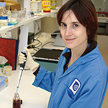Question: Roughly, how many blood cells are there in the human body?
Comments
-
commented on 22 Jun 2011:
I love how you showed your working! If you were my student, you’d get full marks for this question 😉
-
commented on 22 Jun 2011:
Thanks gsweet! yay.
-
-
commented on 22 Jun 2011:
Edward what’s the difference?
-
commented on 22 Jun 2011:
Hi Kate,
Maths doesn’t have to involve numbers or calculations. Here is something out of one of my textbooks:
‘In a locally compact Hausdorff space or a complete metric space, any countable collection of dense open subsets has dense intersection.’
Now, that sounds like total gibberish, which of course it is until we learn the technical meaning of the words that make up 14 of the 21 words that make up the sentence, whereupon this becomes an important statement and requires quite a bit of work to prove that it’s true. The brainwork involves logic, but no arithmetic calculations at all!
-
commented on 22 Jun 2011:
Edward… that’s a stupendous explanation! I love it. (although you are right – to the uneducated maths brain like mine… it does sound like gibberish!)









hi emmajane98,
I’m going to work this out from scratch, since I know the volume of a red blood cell, the volume of blood in the average body and also the percentage of blood that is red blood cells… here goes!
First I know that on average a red blood cell is about 100 femtolitres in volume (1L = 1×10^15 fL)
Then, I know the average person has about 8L of blood.
In blood, the red blood cells take up about 40% of the volume
so
40% of 8L = 3.2L
so in 3.2L there are 3.2 x 10^15 fL. and if a blood cell is 100 fL then there are 3.2 x 10^13 blood cells…
I hope my maths is correct?! can anyone check?
1
Hi Kate,
Arithmetic looks right to me — but then I was never much good at arithmetic (which is why I studied maths). :-p (That’s not entirely a joke, actually!)
0